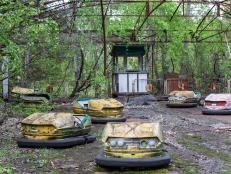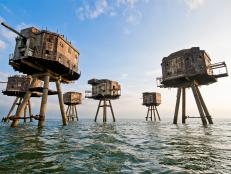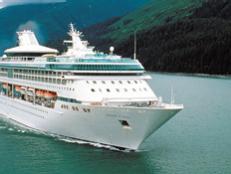22 Reasons Why You Need to Visit Taiwan
Taiwan offers a rich landscape filled with ancient culture and plenty of modern appeal too.

Related To:
lessRelated To:
Taiwan, the Beautiful Island
Called Isla Formosa (Beautiful Island) by Portuguese sailors in the 1500s, Taiwan is an island nation of 24 million people filled with scenic parks, ancient temples, indigenous cultures that date back thousands of years and vibrant cities with luxury shopping and night markets selling traditional foods. Claimed by The Netherlands, Japan and, currently, by the People’s Republic of China throughout its history, Taiwan maintains its independent spirit with diverse cultures and a democratically elected government. Check out these 22 reasons to discover Taiwan that are just a sampling of what this fascinating country has to offer.
National Chiang Kai-Shek Memorial Hall
National Chiang Kai-shek Memorial Hall honors Chiang Kai-shek, leader of the Nationalists who fought the Communists under Mao Zedong during the Chinese Civil War. Chiang Kai-shek is credited with unifying China in the years before World War II, and combating occupying Japanese forces during the war. The Nationalists were pushed out of mainland China after World War II, and Chiang Kai-shek and his Nationalist forces escaped to Taiwan in 1949 where he continued to serve as President of the Republic of China (Taiwan) until his death in 1975. Today, The People’s Republic of China claims the Republic of China (Taiwan) as its territory, while many in Taiwan, which has a democratically elected government, consider the island an independent state. The issue of Taiwan’s political status is still in dispute with China and Taiwan, but economic and cultural ties have improved in recent years.
Tainan, Taiwan's Oldest City
Tainan City is the oldest developed city in Taiwan, and was founded by the Dutch East India Company in 1624. The Dutch Fort Zeelandia was built here to combat Spanish rivals, and was a major trade stop for routes between China, Japan and Europe. It was taken over by Zheng Chenggong of mainland China in 1661, ending Dutch rule of Taiwan. Tainan’s famous Confucius temple was built here in 1662 (pictured) and still stands, and salt production is still practiced here. The British were invited to use Tainan as a trade center after the Dutch, continuing its position as a major international trade city. Tainan (and thereby all of Taiwan) was taken over by Japan in 1895 during the First Sino-Japanese War, and remained under Japanese control until 1945. Today, Tainan is a blend of its international, traditional and indigenous history that dates back thousands of years, and is known for its many Taoist and Buddhist shrines and temples.
Din Tai Fung Restaurant
Din Tai Fung is a Taiwainese restaurant chain, but unlike other chains it has earned a Michelin star, was named as one of the world’s top 10 restaurants by the New York Times in 1993 and is world-renowned for its xiao long bao steamed buns. Started in Taipei in 1972 by Yang Bingyi and Lai Penmei, in 1996 it went international by opening a location in Tokyo, and the first U.S. location opened in California in 2000. London saw its first Din Tai Fung in 2018. Can't jet off to Taipei right now for dinner? Check out these U.S. locations.
Taiwan Cycling Route No. 1
Completed in 2015, Taiwan Cycling Route No. 1 is a 602-mile-long bike path that roughly traces Taiwan and passes by some of the island’s most scenic attractions. Taiwan has a strong bicycling culture, and bicycle manufacturing here for such brands as Giant and Trek have further instilled bike culture in Taiwan.
Gaomei Wetlands
Gaomei Wetlands in Taichung is a favorite local destination for watching and photographing the sunset. Wind turbines line the horizon, and crabs, birds and other life are seen in the sand.
Beitou Hot Springs District
The Beitou District at the north end of Taiwan near Taipei is known for its hot springs. There are public bath houses and private springs with hotels, and massage, acupuncture and other healing arts are available throughout this region.
Dihua Street
Dihua Street is the oldest street in Taipei where traditional herbs, spices, tea and medicine are sold, as well as fabrics and incense. It is particularly busy during Chinese New Year as people stock up on traditional ingredients and items.
Taipei 101
At 1,671 feet tall, Taipei 101 was the tallest building in the world from its 2004 opening until Dubai’s Burj Kahlifa was built in 2010. Now the tenth tallest building in the world, 101-floor Taipei 101 still impresses not only with its pagoda-like design, but also its environmentally friendly LEED Platinum certification, making it the world’s tallest green building. Its first five floors feature a luxury shopping mall. Visitors can ascend to the 88, 89 and 91st floors via 55-feet-per-second elevators and take in 360-degree views of Taipei from 9 a.m. to 10 p.m. Tickets for the observation floors can be purchased at Taipei 101 for $20, or online here.
Rainbow Village, Taichung
Rainbow Village in the Nantun District of Taichung is a neighborhood of brightly colored homes with whimsical scenes that has become an Instagram darling. When resident Huang Yongzhen’s neighborhood, which largely houses veterans, was slated for demolition, he painted his home in vibrant colors in protest. His neighbors asked him to paint their homes, too, and the result saved the community from being torn down. Today Rainbow Village is a popular destination for photography and shopping for locally made art.
Sicao Green Tunnel
The Sicao Green Tunnel is a stretch of mangrove trees that arch over a canal within Taijiang National Park in Tainan and reflect in the water below, creating a picture-perfect scene that can be toured on a 30-minute bamboo boat ride.
Sun Moon Lake
Sun Moon Lake is Taiwan’s largest natural lake and is a favorite destination for photographers and bird watchers. Located in the middle of Taiwan, it’s surrounded by forest. The Xiangshang Visitor Center overlooks the lake with panoramic views, a museum and café.
Shilin Night Market
Shilin Night Market is one of the largest in Taiwan and is a Taipei must-visit. Open from early evening to midnight daily, favorite foods such as Giant Fried Chicken Steak, bubble tea, oyster omelets, fried buns and stinky tofu can be sampled as visitors take in the vibrant local scene. Night markets throughout Taiwan are popluar meeting places and a great way to experience local communities.
Yangmingshan National Park
Located at the northern tip of Taiwan, Yangmingshan National Park is known for its graceful waterfalls, lilies, hot springs and blooming cherry trees. Hiking and biking trails wind through its 44 square miles.
National Palace Museum
The National Palace Museum in Taipei houses some 700,000 artifacts of Chinese history and art that were evacuated from mainland China during the Chinese Civil War in 1949. Works in bronze and jade, books and other items dating to the Tang Dynasty (618 A.D.) are preserved, with a rotating 1 percent of the vast collection displayed at any given time.
Fo Guang Shan Buddha Museum
Opened in 2011, the Fo Guang Shan Buddha Museum in Kaohsiung in southern Taiwan details the traditions of Mahayana Buddhism. Large shrines of the Buddha are displayed on the grounds, and eight pagodas represent a tenet of Mahayana Buddhism such as Giving, Teaching and Goodness. Public programs such as music performances and children’s storytelling take place, and there’s a bookstore.
Shuangliu National Forest Park
Shuangliu National Forest Park in southern Taiwan in Shizi contains 2.5 square miles of forest filled with wildlife, waterfalls and hiking trails. Taiwan has several national forests and recreation areas, including Hehuanshan National Forest Recreation Area and the Northeast and Yilan Coast National Scenic Area with its stunning, surreal rock formations.
Taiwan Indigenous Culture Park
The Taiwan Indigenous Culture Park in Majia Township honors and explains Taiwan’s eight indigenous tribes that have called the island home for thousands of years. Some 800,000 people, or 2.38 percent of Taiwan’s population, identify as belonging to an indigenous group. The Taiwan Indigenous Culture Park highlights the history of these groups, and members of the Bunun Tribe and others showcase their traditional skills, music, food and art.
Maokong Gondola
Taipei’s Maokong Gondola ferries visitors 2.5 scenic miles from the Taipei Zoo 900 vertical feet to Maokong, a traditional center for tea cultivation. Enjoy the zoo, then enjoy a cup of tea at the Tea Promotion Center before seeing Tianen Temple, a Maitreya Buddhist site.
Guandu Temple
The ornate Guandu Temple in the Beitou District of Taipei was constructed in 1712 to worship the goddess Mazu who looks after sailors and fishermen. It’s open to the public and features intricate relief carvings of dragons and tigers, leading to an altar devoted to Mazu.
Lungshan Temple
Lungshan (sometimes Longshan) Temple was built in 1738 as a gathering place for Chinese settlers in Taipei, and is a source of pride for Taiwan where Buddhist, Taoist and traditional Chinese gods are revered. It was partially destroyed by American bombers attacking Imperial Japanese forces in 1945, and rebuilt. It is one of the largest temples in Taiwan and is the site of cultural gatherings throughout the year.
Taroko National Park
Taroko National Park is 400 square miles of soaring mountains, deep gorges, rivers, waterfalls and diverse wildlife throughout its elevation range. Several hiking and mountaineering trails are found throughout the park, and camping is permitted in designated areas. Provincial Highway No. 8 (Su-Hua Highway) cuts through the park and is carved into the cliffsides at times. Currently public buses run this route as private vehicles are not permitted. Taroko is one of Taiwan's ten national parks.
Jiufen
Jiufen is a seaside village that experienced a gold mining boon when gold was discovered there in the 1800s. The gold supply petered out by the 1970s, but in the 1990s Jiufen’s scenic beauty and historic Japanese-style buildings began attracting tourists. Restaurants, shops and cafés overlook the East Chine Sea, and cobblestone streets wind through the hillside village. It attracts tourists from Japan for its resemblance to the village in the 2001 movie Spirited Away. Bed and breakfasts and guesthouses make Jiufen a romantic overnight stay just 39 miles east of Taipei.





